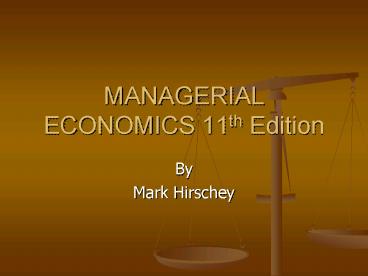MANAGERIAL ECONOMICS 11th Edition - PowerPoint PPT Presentation
1 / 40
Title:
MANAGERIAL ECONOMICS 11th Edition
Description:
Production efficiency is 'what' and 'how' to produce. Production function: A schedule (or table or mathematical equation) showing the ... – PowerPoint PPT presentation
Number of Views:191
Avg rating:3.0/5.0
Title: MANAGERIAL ECONOMICS 11th Edition
1
MANAGERIAL ECONOMICS 11th Edition
- By
- Mark Hirschey
2
Production Analysis and Compensation Policy
- Chapter 8
3
Chapter 8OVERVIEW
- Production Functions
- Total, Marginal, and Average Product
- Law of Diminishing Returns to a Factor
- Input Combination Choice
- Marginal Revenue Product and Optimal Employment
- Optimal Combination of Multiple Inputs
- Optimal Levels of Multiple Inputs
- Returns to Scale
- Productivity Measurement
4
Production Functions
- Production efficiency is what and how to
produce. - Production function A schedule (or table or
mathematical equation) showing the maximum amount
of output that can be produced from any specified
set of inputs given the existing technology. The
production function is a catalog of output
possibilities.
5
- Production functions are determined by
technology, equipment and input prices. - Discrete production function involve distinct
patterns for input combinations. - Continuous production functions employ inputs in
small increments.
6
Returns to Scale and Returns to a Factor
- Two important relations between inputs and
outputs - Returns to scale measure output effect of
increasing all inputs. - Returns to a factor measure output effect of
increasing one input.
7
Total, Marginal, and Average Product
- Total Product
- Total product is total output.
- Marginal Product
- Marginal product is the change in output caused
by increasing input use. - If MPX?Q/?Xgt 0, total product is rising.
- If MPX?Q/?Xlt 0, total product is falling (rare).
- Average product
- APXQ/X.
8
(No Transcript)
9
Law of Diminishing Returns to a Factor
- Diminishing Returns to a Factor Concept As the
number of units of the variable input increases,
other inputs held constant, a point will be
reached beyond which the marginal product
decreases. - MPX tends to diminish as X use grows.
- If MPX grew with use of X, there would be no
limit to input usage. - MPXlt 0 implies irrational input use (rare).
10
(No Transcript)
11
Input Combination Choice
- Production Isoquants
- Isoquant is a curve that represents the different
input combinations used to efficiently produced a
specified output. - Efficiency (technical efficiency) in this case is
achieved when the maximum possible amount of
output is produced at the lowest possible cost.
12
Input Y
8
6
Q91
4
4
3
1
1
2
3
4
5
6
7
8
Input X
13
- Input Factor Substitution (page 246)
- Isoquant shape shows input substitutability.
- Perfect Substitutes Straight lines.
- Perfect Complements Right angles.
- Imperfect Substitutability C-shaped.
14
(No Transcript)
15
Marginal Rate of Technical Substitution
- MRTS Amount of one input that must be
substituted for another to maintain constant
output. - MRTSXY-MPX/MPY (Slope Isoquant)
- Slope Rational Limits of Input Substitution
- MPXlt0 or MPYlt0 are never observed.
16
(No Transcript)
17
(No Transcript)
18
(No Transcript)
19
(No Transcript)
20
(No Transcript)
21
(No Transcript)
22
(No Transcript)
23
Marginal Revenue Product and Optimal Employment
- In order to understand HOW factors of
productions should be combined for maximum
efficiency, we need to shift from the analysis of
the physical productivity of inputs to their
economic productivity, or net revenue-generating
capability. - Marginal Revenue Product
- Amount of revenue generated by employing the last
input unit. - MRPx MPx x MRQ ?TR/?X.
24
(No Transcript)
25
(No Transcript)
26
(No Transcript)
27
Returns to Scale
- Evaluating Returns to Scale
- Returns to scale show the output effect of
increasing all inputs. - Constant returns to scale When a given
percentage increase in all inputs leads to an
identical percentage increase in output - Increasing returns to scale When the
proportional increase in output is larger than an
underlying proportional increase in input - Decreasing returns to scale When output
increases at a rate less than the proportionate
increase in inputs
28
- Output Elasticity and Returns to Scale
- Output elasticity Percentage change in output
associated with a 1 change in all inputs. - Output elasticity is eQ ?Q/Q ?Xi/Xi where Xi
is all inputs (labor, capital, etc.) - eQ gt 1 implies increasing returns.
- eQ 1 implies constant returns.
- eQ lt 1 implies decreasing returns.
29
(No Transcript)
30
(No Transcript)
31
(No Transcript)
32
(No Transcript)
33
Productivity Measurement
- How Is Productivity Measured?
- Productivity measurement is the responsibility of
the Bureau of Labor Statistics (since 1800s). - Productivity growth is the rate of change in
output per unit of input. - Labor productivity is the change in output per
worker hour. - Uses and Limitations of Productivity Data
- Quality changes make productivity measurement
difficult.
34
(No Transcript)
35
Self Test Problem 1
36
(No Transcript)
37
(No Transcript)
38
(No Transcript)
39
Self Test Problem 2
40
(No Transcript)































